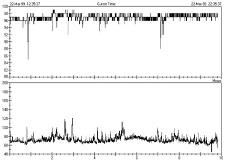PULSE OXIMETRY CHANGES IN A PATIENT WITH SIMPLE PARTIAL SEIZURES - POSSIBLE CONTRIBUTING EVIDENCE TO THE EXPLANATION OF SUDEP
Abstract number :
3.115
Submission category :
Year :
2002
Submission ID :
3545
Source :
www.aesnet.org
Presentation date :
12/7/2002 12:00:00 AM
Published date :
Dec 1, 2002, 06:00 AM
Authors :
Simona Tigaran, Henning Molgaard, Gregory D. Cascino, Allan S. Jaffe, Mogens Dam. Neurology, Aarhus University Hospital, Aarhus, Denmark; Cardiology, Skejby, Aarhus University Hospital, Aarhus, Denmark; of Neurology, Divison of Epilepsy, Mayo Clinic, Roch
RATIONALE: Sudden death in epilepsy (SUDEP) is a fatal illness that may occur in patients with intractable seizure disorders. SUDEP is perhaps related to hemodynamic changes associated with the seizures themselves. The frequency of SUDEP is ten fold greater in patients with frequent seizures compared to 1 per 1000 person-years for the whole population of patients with epilepsy.
METHODS: A 34-years old male with a diagnosis of medically refractory epilepsy was admitted for video-EEG telemetry at Aarhus University Hospital, Department of Neurology. Prior to admission the monthly seizure average was 10, consisting of both complex and simple partial fits.
MRI showed right hippocampal sclerosis.
The routine video-EEG monitor was synchronized with pulse oximeter (disposable digital probes, Novametrix 511 M) and Holter monitors.
After admission all antiepileptic medication was slowly discontinued over a week.
The data were then collected in the patient off antiepileptic drug therapy.
RESULTS: Seven simple partial seizures of 1[onehalf] up to 3 minutes duration were recorded. He was sitting in a chair and watched TV, when he suddenly complained of an odd, light sensation in the head. Subsequently the head, and the whole trunk, respectively, was bent forward to 30[degree] , and a discrete left upper limb tremor was noticed. Afterwards he felt tired for about 15 minutes.
Obstructive sleep apnea was not observed.
In 4 consecutive stereotype seizures as above the recorded pulse oximetry signal was clear and these data were used for subsequent analysis. Seizure number two arose from sleep.
During the seizures, SO2 dropped ictally to 85, 91, 92 and 88. These changes lasted from 1[onehalf] to 2 minutes. All seizures originated from the temporal lobe but there were no overt differences between the onset of seizure activity in the right versus the left lobe. The maximal ictal heart rate ranged from 100-120 beats per minute during the hypoxia.
CONCLUSIONS: We are the first to document oxygen desaturation during simple seizure activity. We have recently demonstrated that ST-segment depression identical to that observed during cardiac ischemia follows epileptic seizures, especially if when there is a sustained increase in heart rate. Oxygen desaturation may contribute to this phenomenon or exacerbate it further.
Solitary reports have demonstrated oxygen desaturation following complex partial seizures without secondary generalization in medicated patients.
The demonstration of the above association between simple partial seizures and oxygen desaturation in seizures of a temporal site onset furthers the sparse information in this area. Due to the deep brain seizure discharges it might be that the central cardio-respiratory reflex is early involved, thus initiating the further cascade of hemodynamic perturbations which might triggeres ischemia and/or malignant arrhythmia and further explain the possible mechanism for SUDEP.[figure1]
